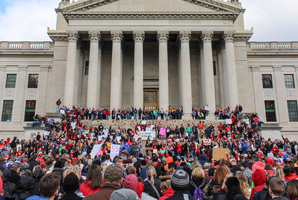
In early 2018, thousands of West Virginia teachers and school service personnel walked off the job over pay and health benefits. During the nine-day work stoppage, educators and their supporters filled the hallways of the Capitol in a dramatic show of solidarity.
It was the first statewide teacher strike in West Virginia since 1990, when teacher pay ranked near the bottom nationally. At the time of the 2018 strike, West Virginia teachers were again among the lowest paid in the country, with an average salary of $44,700.
Talk of teacher action began in fall 2017 when the West Virginia Public Employees Insurance Agency announced proposals that would have led to higher costs for teachers and state employees covered by PEIA. Throughout the work stoppage, PEIA remained as important an issue as pay, which appeared to help educators garner support from the public.
In his State of the State address on January 10, 2018, Governor Jim Justice proposed a one percent pay raise for teachers in 2018 with further raises in subsequent years. The legislature later approved a two percent pay raise, but educators said it was not enough to offset increases in the cost of their health insurance.
At the county level, some teachers began to call for a strike, although union leaders urged them to give the legislature more time to act. Educators in three southern counties, Logan, Mingo and Wyoming, were the first to organize walkouts, calling for “Fed Up Friday,” a one-day outage, on February 2. On February 16, teachers from seven counties participated in work stoppages. When it was clear that no resolution was in sight, the unions announced a statewide strike for February 22-23.
Educators were represented by two statewide union organizations: the West Virginia Education Association, an affiliate of the National Education Association, and the American Federation of Teachers – West Virginia. Unlike the 1990 strike, the 2018 work stoppage also included the West Virginia School Service Personnel Association, swelling the ranks of participants to about 33,000.
Throughout the work stoppage, the union leaders presented a unified front, but rank-and-file teachers and service employees did not always follow their lead. On February 28, union leaders spoke in support of a proposed deal and urged strikers to return to work. The deal fell apart, however, and teachers remained out of the classroom.
Over nine school days, thousands of educators and their supporters crowded into the Capitol building in Charleston. With rallying cries of “55 Strong” and “55 United,” they also staged protests in their home counties. The teachers wore red shirts, according to some a reminder of the red bandanas worn by militant miners during the West Virginia Mine Wars. Teacher strikers in other states later adopted the red coloration.
Several national labor leaders joined the protesters, including Randi Weingarten, president of the American Federation of Teachers, and Lily Eskelsen Garcia, president of the National Education Association. Cecil Roberts, president of the United Mine Workers, also addressed educators gathered at the Capitol.
Finally, on March 6, the governor and the legislature agreed to a five percent raise for teachers and school service personnel, and for all state workers. Changes to PEIA were frozen, and a task force was created to look for solutions to the agency’s financial woes. The legislature backed off on other measures of concern to educators, including one that would have altered teacher seniority and another that would have prevented payroll deductions for union dues. The strike ended with a return to the classroom on March 7.
The West Virginia teachers strike drew national attention and inspired educators in other states to follow suit. In April and May, teachers in Kentucky, Oklahoma, Arizona, Colorado and North Carolina organized work stoppages over pay and benefits, as well as state funding for education.
This Article was written by Becky Calwell
Last Revised on August 03, 2018
Cite This Article
Calwell, Becky "Teachers Strike of 2018." e-WV: The West Virginia Encyclopedia. 03 August 2018. Web. 26 July 2024.






Comments?
There aren't any comments for this article yet.
Click here to read and contribute to the discussion →